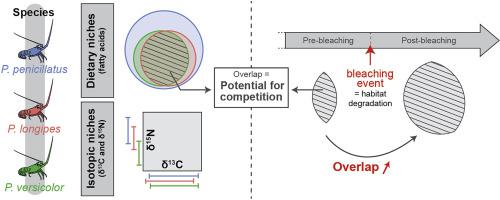Estuarine, Coastal and Shelf Science ( IF 2.6 ) Pub Date : 2021-04-16 , DOI: 10.1016/j.ecss.2021.107368 Magali A. Sabino , Rodney Govinden , Heidi Pethybridge , Laura Blamey , Fabienne LE. Grand , Fany Sardenne , Maria Rose , Paco Bustamante , Nathalie Bodin

|
Spiny lobsters (P. penicillatus, P. longipes and P. versicolor) are heavily dependent on habitats like coral reefs, known to be highly vulnerable to climate change-driven degradation. Yet, little is known about their trophic ecology and their adaptive capacity to a changing environment. In this study, we used fatty acids (FA) analysed in the hepatopancreas and δ13C and δ15N stable isotopes analysed in the tail muscle of three spiny lobster species from the Seychelles coastal waters to (1) infer habitat use, dietary patterns and potential for resource competition and (2) investigate the effects of reef type and coral bleaching on their trophic niche metrics. We found that there was a potential for interspecific competition between the three species, shown by their high dietary overlap (mean FA niche overlap ranging from 71.2% to 99.5% for P. longipes and P. versicolor in P. penicillatus) and similar habitat use (δ13C value ranges). P. penicillatus, the largest of the three species, was more a generalist than the two other species (i.e., had a larger FA niche) and P. versicolor seemed to feed on smaller/earlier life stage prey than P. longipes (based on differences in δ15N values). The potential for resource competition of Seychelles spiny lobsters appeared higher in granite than carbonate reefs, and in post-2016 coral bleaching reefs. Our results suggest that P. penicillatus could have a greater adaptive capacity to climate change due to its higher dietary plasticity and that competition between Seychelles spiny lobsters may increase in the future as the frequency and severity of bleaching events is predicted to increase with climate change.
中文翻译:

栖息地退化增加了塞舌尔三种刺龙虾物种之间的种间营养竞争
多刺龙虾(P. penicillatus,P。longipes和P. versicolor)在很大程度上依赖于像珊瑚礁这样的栖息地,众所周知,它们很容易受到气候变化驱动的退化的影响。然而,人们对它们的营养生态学和对不断变化的环境的适应能力知之甚少。在这项研究中,我们使用的脂肪酸(FA)的肝胰腺和δ分析13 C和δ 15在塞舌尔沿海水域的三种多刺龙虾物种的尾部肌肉中分析了N稳定同位素,以(1)推断栖息地的利用,饮食模式和资源竞争的潜力,(2)研究礁石类型和珊瑚漂白对其营养性利基的影响指标。我们发现,有三个种间竞争的影响,通过其高膳食重叠(平均FA生态位重叠范围从71.2%至99.5%,显示潜在P.长柄和P.花斑癣在P.长毛)和类似的栖息地利用(δ 13米C值范围)。P. penicillatus,这三个物种中最大的一个,比其他两个物种(即具有较大的FA生态位)更具通才,云芝P.似乎较小/早期生命阶段猎物比进料P.长柄(基于δ差异15的N值)。塞舌尔刺龙虾的资源竞争潜力似乎比花岗岩和碳酸盐礁以及2016年后的珊瑚漂白礁高。我们的研究结果表明,由于P. penicillatus的膳食可塑性更高,它对气候变化的适应能力可能更高,并且随着气候变化,漂白事件的频率和严重性预计会增加,未来塞舌尔多刺龙虾之间的竞争可能会加剧。










































 京公网安备 11010802027423号
京公网安备 11010802027423号